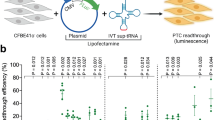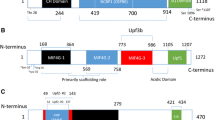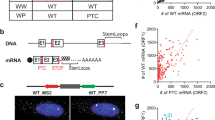Abstract
The nonsense-mediated decay (NMD) pathway is an mRNA surveillance mechanism that detects and degrades transcripts containing premature termination codons. The position of a truncating mutation can govern the resulting phenotype as mutations in the last exon evade NMD. In this study we investigated the susceptibility to NMD of six truncating HNF-1beta mutations by allele-specific quantitative real-time PCR using transformed lymphoblastoid cell lines. Four of six mutations (R181X, Q243fsdelC, P328L329fsdelCCTCT and A373fsdel29) showed evidence of NMD with levels of mutant transcript at 71% (p=0.009), 24% (p=0.008), 22% (p=0.008) and 3% (p=0.016) of the wild-type allele respectively. Comparable results were derived from lymphoblastoid cells and renal tubule cells isolated from a patient’s overnight urine confirming that cell lines provide a good model for mRNA analysis. Two mutations (H69fsdelAC and P159fsdelT) produced transcripts unexpectedly immune to NMD. We conclude that truncating mutant transcripts of the HNF-1beta gene do not conform to the known rules governing NMD susceptibility, but instead demonstrate a previously unreported 5′ to 3′ polarity. We hypothesise that this may be due to reinitiation of translation downstream of the premature termination codon. Our study suggests that reinitiation of translation may be an important mechanism in the evasion of NMD, but that other factors such as the distance from the native initiation codon may also play a part.




Similar content being viewed by others
Abbreviations
- CHX:
-
Cycloheximide
- DMSO:
-
dimethyl sulphoxide
- ESE:
-
exon splicing enhancer
- ESS:
-
Exon splicing silencer
- GCKD:
-
glomerulocystic kidney disease
- HNF-1β:
-
Hepatocyte nuclear factor-1 beta
- ISE:
-
intron splicing enhancer
- ISS:
-
intron splicing silencer
- MODY:
-
Maturity-onset diabetes of the young
- NMD:
-
Nonsense-mediated decay
- PBS:
-
phosphate buffered saline
- PTC:
-
premature termination codon
- RCAD:
-
Renal cysts and diabetes syndrome
- RT-PCR:
-
Reverse transcription PCR
References
Applied-Biosystems (2001) Relative quantitation of gene expression. User bulletin 2:11–15
Asselta R, Duga S, Spena S, Santagostino E, Peyvandi F, Piseddu G, Targhetta R, Malcovati M, Mannucci PM, Tenchini ML (2001) Congenital afibrinogenemia: mutations leading to premature termination codons in fibrinogen A alpha-chain gene are not associated with the decay of the mutant mRNAs. Blood 98:3685–92
Bach I, Yaniv M (1993) More potent transcriptional activators or a transdominant inhibitor of the HNF1 homeoprotein family are generated by alternative RNA preocessing. The EMBO Journal 12:4229–4242
Belgrader P, Cheng J, Maquat LE (1993) Evidence to implicate translation by ribosomes in the mechanism by which nonsense codons reduce the nuclear level of human triosephosphate isomerase mRNA. Proc Natl Acad Sci USA 90:482–6
Bellanne-Chantelot C, Chauveau D, Gautier JF, Dubois-Laforgue D, Clauin S, Beaufils S, Wilhelm JM, Boitard C, Noel LH, Velho G, Timsit J (2004) Clinical spectrum associated with hepatocyte nuclear factor-1beta mutations. Ann Intern Med 140:510–7
Bingham C, Hattersley AT (2004) Renal cysts and diabetes syndrome resulting from mutations in hepatocyte nuclear factor-1 beta. Nephrol Dial Transplant 19:2703–2708
Bingham C, Ellard S, Allen L, Bulman M, Shepherd M, Frayling T, Berry PJ, Clark PM, Lindner T, Bell GI, Ryffel GU, Nicholls AJ, Hattersley AT (2000) Abnormal nephron development associated with a frameshift mutation in the transcription factor hepatocyte nuclear factor-1 beta. Kidney International 57(3):898–907
Bingham C, Bulman M, Ellard S, Allen L, Lipkin G, van’t Hoff W, Woolf A, Rizzoni G, Novelli G, Nicholls A, Hattersley A (2001) Mutations in the HNF1-beta gene are associated with familial hypoplastic glomerulocystic kidney disease. American Journal of Human Genetics 68:219–224
Bingham C, Ellard S, Cole TR, Jones KE, Allen LI, Goodship JA, Goodship TH, Bakalinova-Pugh D, Russell GI, Woolf AS, Nicholls AJ, Hattersley AT (2002) Solitary functioning kidney and diverse genital tract malformations associated with hepatocyte nuclear factor-1beta mutations. Kidney Int 61:1243–51
Bohn S, Thomas H, Turan G, Ellard S, Bingham C, Hattersley AT, Ryffel GU (2003) Distinct molecular and morphogenetic properties of mutations in the human HNF1beta gene that lead to defective kidney development. J Am Soc Nephrol 14:2033–41
Brocke KS, Neu-Yilik G, Gehring NH, Hentze MW, Kulozik AE (2002) The human intronless melanocortin 4-receptor gene is NMD insensitive. Hum Mol Genet 11:331–5
Buhler M, Paillusson A, Muhlemann O (2004) Efficient downregulation of immunoglobulin mu mRNA with premature translation-termination codons requires the 5′-half of the VDJ exon. Nucleic Acids Res 32:3304–15
Bulman MP, Harries LW, Hansen T, Shepherd M, Kelly WF, Hattersley AT, Ellard S (2002) Abnormal splicing of hepatocyte nuclear factor 1 alpha in maturity-onset diabetes of the young. Diabetologia 45:1463–7
Buzina A, Shulman MJ (1999) Infrequent translation of a nonsense codon is sufficient to decrease mRNA level. Mol Biol Cell 10:515–24
Byers PH (2002) Killing the messenger: new insights into nonsense-mediated mRNA decay. J Clin Invest 109:3–6
Cartegni L, Chew SL, Krainer AR (2002) Listening to silence and understanding nonsense: exonic mutations that affect splicing. Nat Rev Genet 3:285–98
Carter MS, Li S, Wilkinson MF (1996) A splicing-dependent regulatory mechanism that detects translation signals. Embo J 15:5965–75
Cereghini S, Ott MO, Power S, Maury M (1992) Expression patterns of vHNF1 and HNF1 homeoproteins in early postimplantation embryos suggest distinct and sequential developmental roles. Development 116:783–97
Cheng J, Belgrader P, Zhou X, Maquat LE (1994) Introns are cis effectors of the nonsense-codon-mediated reduction in nuclear mRNA abundance. Mol Cell Biol 14:6317–25
Coffinier C, Barra J, Babinet C, Yaniv M (1999) Expression of the vHNF1/HNF1beta homeoprotein gene during mouse organogenesis. Mech Dev 89:211–3
Denecke J, Kranz C, Kemming D, Koch HG, Marquardt T (2004) An activated 5′ cryptic splice site in the human ALG3 gene generates a premature termination codon insensitive to nonsense-mediated mRNA decay in a new case of congenital disorder of glycosylation type Id (CDG-Id). Hum Mutat 23:477–86
Dietz HC, McIntosh I, Sakai LY, Corson GM, Chalberg SC, Pyeritz RE, Francomano CA (1993) Four novel FBN1 mutations: significance for mutant transcript level and EGF-like domain calcium binding in the pathogenesis of Marfan syndrome. Genomics 17:468–75
Eeckhoute J, Moerman E, Bouckenooghe T, Lukoviak B, Pattou F, Formstecher P, Kerr-Conte J, Vandewalle B, Laine B (2003) Hepatocyte nuclear factor 4 alpha isoforms originated from the P1 promoter are expressed in human pancreatic beta-cells and exhibit stronger transcriptional potentials than P2 promoter-driven isoforms. Endocrinology 144:1686–94
Frischmeyer PA, Dietz HC (1999) Nonsense-mediated mRNA decay in health and disease. Human Molecular Genetics 8:1893–1900
Furuta H, Iwasaki N, Oda N, Hinokio Y, Horikawa Y, Yamagata K, Yano N, Sugahiro J, Ogata M, Ohgawara H, Omori Y, Iwamoto Y, Bell GI (1997) Organization and partial sequence of the hepatocyte nuclear factor-4α/MODY1 gene and identification of a missense mutation R127W, in a Japanese family with MODY. Diabetes 46:1652–7
Hansen SK, Parrizas M, Jensen ML, Pruhova S, Ek J, Boj SF, Johansen A, Maestro MA, Rivera F, Eiberg H, Andel M, Lebl J, Pedersen O, Ferrer J, Hansen T (2002) Genetic evidence that HNF-1alpha-dependent transcriptional control of HNF-4alpha is essential for human pancreatic beta cell function. J Clin Invest 110:827–33
Harries LW, Ellard S, Jones RW, Hattersley AT, Bingham C (2004a) Abnormal splicing of hepatocyte nuclear factor-1 beta in the renal cysts and diabetes syndrome. Diabetologia 47:937–42
Harries LW, Hattersley AT, Ellard S (2004b) Messenger RNA transcripts of the hepatocyte nuclear factor-1alpha gene containing premature termination codons are subject to nonsense-mediated decay. Diabetes 53:500–4
Haumaitre C, Reber M, Cereghini S (2003) Functions of HNF1 family members in differentiation of the visceral endoderm cell lineage. J Biol Chem 278:40933–42
Hillman RT, Green RE, Brenner SE (2004) An unappreciated role for RNA surveillance. Genome Biol 5:R8
Inacio A, Silva AL, Pinto J, Ji X, Morgado A, Almeida F, Faustino P, Lavinha J, Liebhaber SA, Romao L (2004) Nonsense mutations in close proximity to the initiation codon fail to trigger full nonsense-mediated mRNA decay. J Biol Chem
Inoue K, Khajavi M, Ohyama T, Hirabayashi S, Wilson J, Reggin JD, Mancias P, Butler IJ, Wilkinson MF, Wegner M, Lupski JR (2004) Molecular mechanism for distinct neurological phenotypes conveyed by allelic truncating mutations. Nat Genet 36:361–9
Kitanaka S, Miki Y, Hayashi Y, Igarashi T (2004) Promoter-specific repression of hepatocyte nuclear factor (HNF)-1 beta and HNF-1 alpha transcriptional activity by an HNF-1 beta missense mutant associated with Type 5 maturity-onset diabetes of the young with hepatic and biliary manifestations. J Clin Endocrinol Metab 89:1369–78
Kozak M (1989a) Context effects and inefficient initiation at non-AUG codons in eucaryotic cell-free translation systems. Mol Cell Biol 9:5073–80
Kozak M (1989b) The scanning model for translation: an update. J Cell Biol 108:229–41
Le Hir H, Moore MJ, Maquat LE (2000) Pre-mRNA splicing alters mRNP composition: evidence for stable association of proteins at exon-exon junctions. Genes Dev 14:1098–108
Liu H, Cartegni L, Zhang MQ, Krainer AR (2001) A mechanism for exon skipping caused by nonsense or missense mutations in BRCA1 and other genes. Nat Genet 27:55–58
Lykke-Andersen J (2001) mRNA quality control: Marking the message for life or death. Curr Biol 11:R88–91
Mache CJ, Preisegger KH, Kopp S, Ratschek M, Ring E (2002) De novo HNF-1beta gene mutation in familial hypoplastic glomerulocystic kidney disease. Pediatr Nephrol 17:1021–6
Maestro MA, Boj SF, Luco RF, Pierreux CE, Cabedo J, Servitja JM, German MS, Rousseau GG, Lemaigre FP, Ferrer J (2003) Hnf6 and Tcf2 (MODY5) are linked in a gene network operating in a precursor cell domain of the embryonic pancreas. Hum Mol Genet 12:3307–14
Mendel DB, Hansen LP, Graves MK, Conley PB, Crabtree GR (1991) HNF-1a and HNF-1b (vHNF-1) share dimerisation and homeo domains, but not activation domains, and form heterodimers in vitro. Genes and Development 5:1042–1056
Ohno K, Milone M, Shen XM, Engel AG (2003) A frameshifting mutation in CHRNE unmasks skipping of the preceding exon. Hum Mol Genet 12:3055–66
Ott MO, Rey-Campos J, Cereghini S, Yaniv M (1991) vHNF1 is expressed in epithelial cells of distinct embryonic origin during development and precedes HNF1 expression. Mech Dev 36:47–58
Pearson ER, Badman MK, Lockwood CR, Clark PM, Ellard S, Bingham C, Hattersley AT (2004) Contrasting diabetes phenotypes associated with hepatocyte nuclear factor-1alpha and −1beta mutations. Diabetes Care 27:1102–7
Perrin-Vidoz L, Sinilnikova OM, Stoppa-Lyonnet D, Lenoir GM, Mazoyer S (2002) The nonsense-mediated mRNA decay pathway triggers degradation of most BRCA1 mRNAs bearing premature termination codons. Hum Mol Genet 11:2805–14
Pontoglio M, Barra J, Hadchouel M, Doyen A, Kress C, Poggi Bach J, Babinet C, Yaniv M (1996) Hepatocyte nuclear factor 1 inactivation results in hepatic dysfunction, phenylketonuria, and renal fanconi syndrome. Cell 84:575–585
Ryffel GU (2001) Mutations in the human genes encoding the transcription factors of the hepatocyte nuclear factor (HNF)1 and HNF4 families: functional and pathological consequences. J Mol Endocrinol 27:11–29
Schrijver I, Liu W, Odom R, Brenn T, Oefner P, Furthmayr H, Francke U (2002) Premature termination mutations in FBN1: distinct effects on differential allelic expression and on protein and clinical phenotypes. Am J Hum Genet 71:223–37
Shihara N, Horikawa Y, Onishi T, Ono M, Kashimada K, Takeda J (2004) Identification of a new case of hepatocyte nuclear factor-1beta mutation with highly varied phenotypes. Diabetologia 47:1128–9
Waller SC, Rees L, Woolf AS, Ellard S, Pearson ER, Hattersley AT, Bingham C (2002) Severe hyperglycemia after renal transplantation in a pediatric patient with a mutation of the hepatocyte nuclear factor-1beta gene. Am J Kidney Dis 40:1325–30
Wang J, Chang YF, Hamilton JI, Wilkinson MF (2002a) Nonsense-associated altered splicing: a frame-dependent response distinct from nonsense-mediated decay. Mol Cell 10:951–7
Wang J, Gudikote JP, Olivas OR, Wilkinson MF (2002b) Boundary-independent polar nonsense-mediated decay. EMBO Rep 3:274–9
Wild W, Pogge v. Strandmann E, Nastos A, Senkel S, Lingott-Frieg A, Bulman M, Bingham C, Ellard S, Hattersley AT, Ryffel GU (2000) The mutated human gene encoding hepatocyte nuclear factor 1ß inhibits kidney formation in developing Xenopus embryos. PNAS 97(9):4695–700
Wu GD, Chen L, Forslund K, Traber PG (1994) Hepatocyte nuclear factor-1 alpha (HNF-1 alpha) and HNF-1 beta regulate transcription via two elements in an intestine-specific promoter. J Biol Chem 269:17080–5
Yorifuji T, Kurokawa K, Mamada M, Imai T, Kawai M, Nishi Y, Shishido S, Hasegawa Y, Nakahata T (2004) Neonatal diabetes mellitus and neonatal polycystic, dysplastic kidneys: phenotypically discordant recurrence of a mutation in the hepatocyte nuclear factor-1beta gene due to germline mosaicism. J Clin Endocrinol Metab 89:2905–8
Yoshiuchi I, Yamagata K, Zhu Q, Tamada I, Takahashi Y, Onigata K, Takeda J, Miyagawa J, Matsuzawa Y (2002) Identification of a gain-of-function mutation in the HNF-1beta gene in a Japanese family with MODY. Diabetologia 45:154–5
Zhang J, Maquat LE (1997) Evidence that translation reinitiation abrogates nonsense-mediated mRNA decay in mammalian cells. Embo J 16: 826–33
Zhang J, Sun X, Qian Y, LaDuca JP, Maquat LE (1998) At least one intron is required for the nonsense-mediated decay of triosephosphate isomerase mRNA: a possible link between nuclear splicing and cytoplasmic translation. Mol Cell Biol 18:5272–83
Acknowledgements
We are very grateful to Professor Gerhart Ryffel for his constructive discussion of the concepts detailed in this paper. We would like to thank Lisa Allen for sequencing the A373fsdel29 mutation. We thank the Wellcome trust, Diabetes UK, the National Kidney Research Fund (Grant TF13/ 2000), the European Union (Contract number QLG-CT-1999–00546 [GIFT]) and the Royal Devon & Exeter NHS Foundation Trust R &D directorate for financial support. ATH is a Wellcome Trust research leave fellow and CB is a NKRF clinical research fellow. The European Collection of Cell Cultures (ECACC) kindly provided the cell lines.
Author information
Authors and Affiliations
Corresponding author
Rights and permissions
About this article
Cite this article
Harries, L.W., Bingham, C., Bellanne-Chantelot, C. et al. The position of premature termination codons in the hepatocyte nuclear factor −1 beta gene determines susceptibility to nonsense-mediated decay. Hum Genet 118, 214–224 (2005). https://doi.org/10.1007/s00439-005-0023-y
Received:
Accepted:
Published:
Issue Date:
DOI: https://doi.org/10.1007/s00439-005-0023-y




